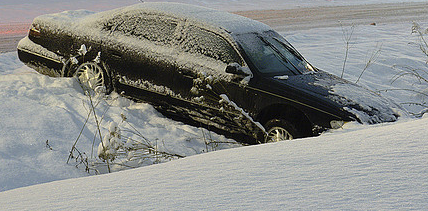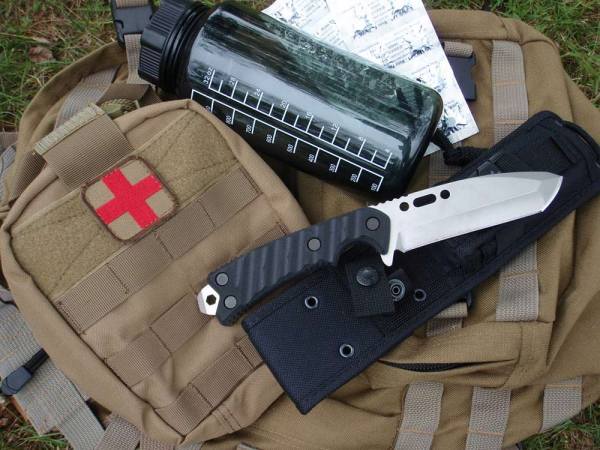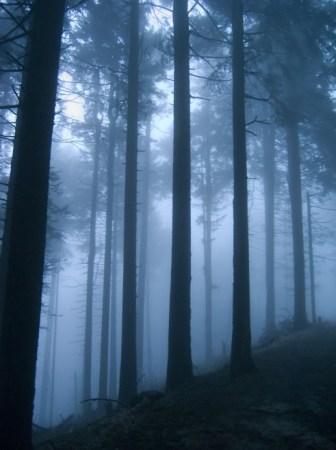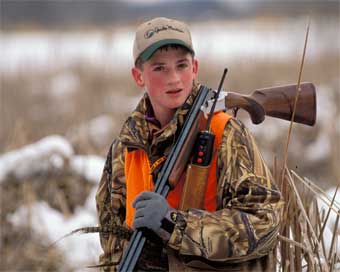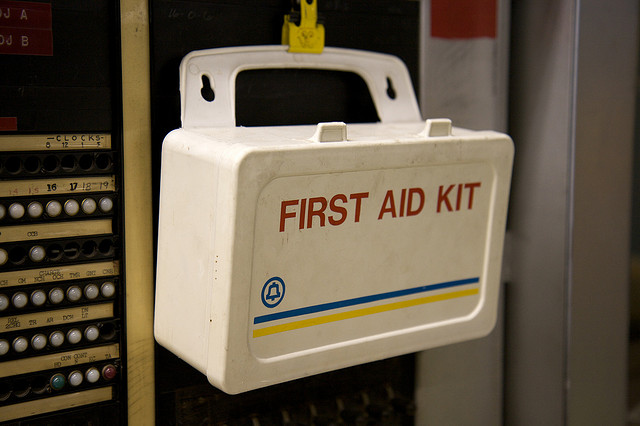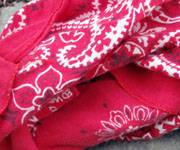207. WALK THE WALK When you’re hiking, never step on anything you can step over or around. Give up elevation grudgingly, unless you know you won’t have to walk uphill again.
208. UNDER COVER When it comes to shelter, clothing is the first line of defense. Wear long-sleeved shirts and full-length pants. Such clothing protects in hot or cold weather because it helps control body temperature and reduce dehydration. Long clothing also helps prevent sunburn, scrapes, bites and other minor injuries.
209. EXTRA GRUB No matter how long your trip is supposed to last, take enough compact, high-calorie emergency food (such as energy bars) to last a few extra days. Starvation might not be a primary concern, but mental and physical faculties deteriorate quickly after a few days without sustenance. In a weakened state, you could get seriously hurt.
210. CRUDE COMPASS Thrust a stick into the ground at a slight angle. The degree of angle doesn’t really matter, because all you need is to have the tip of the shadow off to one side so you can monitor its movement as the sun travels. The taller the stick, the faster the shadow will move across the ground. The tip of the shadow will move from west to east.
211. CAT ATTACK If a cougar attacks you, try to stay on your feet and fight with whatever’s available–a knife, stick, rock, backpack or club. The cat intends to kill you.
212. KNOW YOUR SURROUNDINGS Study the slope of the ground, the way natural drainages flow and the direction in which trees and shrubs have been bent by the prevailing wind. Memorize eye-catching and unique landmarks. Every so often, turn around and study your back trail to get clues about what it should look like on the return trip. As you walk, tie bits of bright surveyor’s tape to twigs at eye level, attaching the next one while you’re still able to see the last one. Position the markers so they’ll be visible from a back-trail perspective. Remove the trail markers as you hike out.
213 Sun Gone? Hunker Down If you’re caught away from camp at night, stop where you are, start a fire and wait until morning to continue on. If conditions are severe, build a shelter to protect against the elements. If the weather isn’t a concern, it might be sufficient to wrap up in your Space Blanket and sleep in a pile of pine duff. The point is to discontinue travel until daylight for safety’s sake.
214. ORIENT A MAP Maps are printed with north at the top, and you need to orient a map so it agrees with the actual direction of north. Lay the map flat and use a compass to align the map so it and the compass both point north.
215. PRIORITY LIST Establishing survival priorities is critical. Depending on conditions, emergency medical care, shelter, a fire for warmth or signaling, drinking water or food will head the priority list. In emergencies, analyze the situation and decide which action is most important under the circumstances.
216. CONTROL FEAR
Uncontrolled fear is an enemy that can keep you from doing the things you need to do to stay alive. If you’re in a survival situation and someone has suffered a fear-generated breakdown, there are things you can do to help.
–Speak calmly and confidently about the situation. Your attitude and behavior will have a huge impact on others in the party.
–Formulate a plan. Organize the work to be done. Set priorities according to the demands of the particular situation.
–Lead by example, not by edict. Get up and start doing the most important tasks, and ask others to help. To avoid confusion, be very clear about the way the tasks should be done.
–Consult with everyone. One person rarely has all the best answers. Express gratitude for the input of others. Instill a sense of teamwork in everyone.
–Upgrade living conditions. A shelter not only protects against the elements, but also gives the mental impression of security. A fire at night wards off fear of the darkness and lends psychological comfort. One hot meal per day will make life bearable. Stay as clean as possible–hygiene is important not only to prevent disease, but to help maintain dignity as well.
–Actively promote rescue through the use of signal devices and techniques.
–Remain optimistic and speak in positive terms to others.
217 Float on Waders If you become submerged in a swift current while wearing hip or chest waders, shed the waders as quickly as you can, get to the surface and try to empty the waders of water. Then allow the waders to fill with air, clamp off their open ends by rolling them up and use them as a flotation device. After reaching safety, put the waders back on to help protect against foot injury and frostbite.
218. TAKE STOCK If you become lost, take inventory of everything on your body, in your pack and in your vehicle or camp, and think creatively about all the possible uses for these items. Examine what nature has provided that will add to your inventory. Deadfall, bushes, tree limbs, boulders or an overhanging ledge can all provide shelter. A stream, snow bank or pond is a water supply. Dry wood, fibrous bark and dead grasses will fuel a fire.
219. SAVE STRENGTH Extend your food and water supply by not overworking or wasting energy on useless activities.
220. BOIL ALL WATER To kill waterborne bacteria, bring water to a rolling boil for one minute at sea level and one additional minute for every 1,000 feet of elevation above sea level. If you don’t know your elevation, boil water for 10 minutes just to be absolutely sure.
221 Reading a Wristwatch Compass
In a broad, General sense, the hands of an analog watch can indicate direction. Assuming you’re in the northern hemisphere, hold the watch horizontally and point the hour hand toward the sun. Bisect the angle between the hour hand and 12 o’clock. The bisecting line will point in a southerly direction.
If your watch is digital, draw the face of an analog watch on a piece of paper and use it to achieve the same results.
222. SICK OF HEIGHTS The primary symptoms of altitude sickness are headache, loss of appetite, nausea, fatigue, light-headedness, difficulty in sleeping, confusion and staggering. To avoid them, ascend slowly over a prolonged period of time. Ascending beyond 8,000 feet should be done at a rate of no more than 1,500 feet per day. The best remedy is to descend to a lower elevation.
223. THREE LEVELS OF BLEEDING
Capillary bleeding: Evident in a slowly oozing wound; often caused by simple abrasions. Check the wound for foreign matter and, if any is present, gently remove it. Swab the wound with a diluted anti-septic solution. Use a dry, non-adherent dressing if necessary.
Venous bleeding: Dark red blood pours from the wound slowly but steadily. Check the wound for foreign objects. Stop the bleeding. Use a non-adherent dressing if necessary and wrap it with a roller bandage. Immobilize and elevate the injury above the heart level.
Arterial bleeding: Distinguished by spurts of bright red blood with each heartbeat. This is a life-threatening emergency. Check for foreign matter in the wound. Apply direct pressure to stop the bleeding. Apply a non-adherent dressing, followed by a pad. Lay the victim down. Immobilize and elevate the injury above the level of the heart. Apply a roller bandage. Treat for shock. Call an ambulance or transport the victim to an emergency medical facility immediately.
224 Make Yourself Seen
FIRE: At night, keep at least one signal fire going. Three fires arranged in a line or in a triangle constitute a recognized distress signal. Try to position the signal fire in a clearing, so it can be seen from a distance.
SMOKE: During daylight hours, smoke from a signal fire might be visible for miles. If oil or rubber is available, burn it to produce black smoke (deflate spare tires before burning). Small amounts of green or wet foliage fed carefully into the fire will produce billowing white smoke.
MOTION: Movement will attract attention. When you think searchers are near, wave a colorful shirt. Keep a large piece of colored cloth tied to the top of a pole at all times, in case searchers are glassing your locale.
COLOR AND PATTERN: Lay out a pattern of colored or contrasting items (clothing, backpacks, rocks, boughs or logs) in a clearing, or even dig a trench. Make the “sign” as large as possible, and create as much contrast as you can. “SOS” and “HELP” are universally understood, but a large “V” is a recognized distress signal, too, and doesn’t require as much material. If medical assistance is needed, make a large “X.”
NOISE: Sounds grouped in sets of three–whether gunshots, whistles or blasts on a horn–also are recognized distress signals. Don’t shout for help. Blowing a whistle requires less energy than screaming, and the sound of your own desperate voice might frighten you more. If you’re in a group, screaming might be all it takes to unhinge your partners, too.
REFLECTION: If you don’t have a signal mirror, use anything shiny–the bottom of a tin plate, the blade of a knife, a belt buckle, a compact disc, a binocular lens, even the polished connector sleeve of a tent pole.
225 Carry Extra Fire Starters Carry at least three separate fire-starters: one in your pants pocket, one in your jacket and one in your pack. Choose from among waterproof and windproof matches, a stormproof lighter, flint and steel and road flares, among others.
226. DON’T DRY UP If you don’t have water to drink, forego eating for a while. Digestion of food speeds the metabolic rate, which adds heat to the body and increases water loss.
227. DETECTING FROSTBITE As the skin freezes, it loses sensation and turns a grayish or yellowish white. The flesh becomes stiff and crisp to the touch. If you’re with friends, watch each other for signs of freezing tissue. If you’re alone, use a signal mirror to inspect yourself.
228. CRAMPS CURE If muscle cramps become chronic, stop to rest and drink plenty of water. Recovery usually comes quickly, but quit all strenuous activity for the rest of the day and allow muscles to rehydrate.
229. KO’D BY HEAT
The skin of someone who is suffering from heat exhaustion might appear gray and will be cold and clammy. The victim will feel weak, dizzy and nauseated, and he might collapse. Get him out of the heat. He is in shock, so place him flat on his back and elevate his feet slightly. If the patient is conscious, give him water to drink in small, steady amounts.
In mild cases, patients recover fairly quickly, skin color returns to normal and the victim begins to feel better. Even so, don’t let him resume physical activity for the rest of the day. In severe cases in which the patient fails to recover, transport him to the nearest emergency medical facility immediately.
230. STROKING OUT Heatstroke can kill in 30 minutes, and it’s always fatal unless properly treated. The most obvious symptom is dry, hot-to-the-touch, flushed skin. At this stage, body temperature will rise rapidly and dangerously, so try to decrease it as quickly as possible. Get the patient out of the heat and immerse him in cool water, or cover him with a wet cloth and fan the body to increase evaporation. Transport the victim to an emergency medical facility as soon as possible.
231. SIGNS OF A HEART ATTACK A heart attack might feel like pressure or squeezing, or a fullness or sharp pain in the chest. A heart attack can last for several minutes, or it might subside and then return. There might be discomfort or pain in one or both arms, or in the back, neck, jaw or stomach. Shortness of breath can occur at the same time as chest discomfort, or before its onset. Other symptoms include nausea, lightheadedness and a cold sweat.
232. THE BIG CHILL Hypothermia is caused by dampness that robs the body of heat. It can result from working up a sweat while chasing a buck or from falling through ice into frigid water. All that matters is that you got wet and your core temperature was reduced. To avoid sweating, dress in layers that are easy to open or remove. Carry heavy outer layers of clothing in a waterproof bag or backpack, and put them on only when needed. Shell layers should have adjustable armpit ventilation to allow perspiration to escape.
233. LEAVE IT IN If a puncture wound involves an impaled object, it must be treated carefully. Do not disturb the impaled object, as it might increase bleeding. Apply pressure to stop bleeding and stabilize the impaled object so it can’t move. Apply a roller bandage and immobilize and elevate the injury above the level of the heart. Transport the victim to an emergency medical facility.
234. WHEN EVERY BREATH COUNTS If a victim still has a heartbeat but is having trouble breathing, perform Rescue Breathing. Gently tilt back the victim’s head and lift the chin, then pinch the nose shut. Seal your mouth around the mouth of the victim and deliver two slow breaths. Continue blowing until the chest gently rises. Check for a pulse. If a pulse is present but the victim is still not breathing, continue delivering one slow breath about every five seconds. Repeat for a minute, or 12 breaths in all. Check for a pulse and breathing after every minute.
235 Administering CPR
Ideally you should be trained in CPR (cardiopulmonary resuscitation) by a professional before performing the procedure. The process is slightly different for children and adults. Following is a brief description of adult CPR, which is performed only on persons who are not breathing and have no pulse.
1. Begin CPR by gently tilting back the victim’s head to open the airway, then listen for breathing. Opening the airway alone might be enough to stimulate breathing.
2. If not, pinch the victim’s nose shut, seal your lips around his mouth and deliver two full breaths.
3. Place the heel of your hand a couple of inches above the bottom of the sternum (called the xiphoid process) and stack your other hand on top of the first.
Press down on the victim’s chest 1 1/2 to 2 inches.
Compress the chest 15 times, then deliver two more full breaths.
4. Pump at a rate of 100 beats per minute, continuing the “15 pumps, two breaths” routine until help arrives or the victim recovers.
236. BEARS BEGONE
Food and garbage bring bears into camp. Here’s how to keep bruins at bay:
–Hang food, toiletries and garbage from a high branch a reasonable distance from camp.
–Don’t sleep in the same clothes you wore while cooking and eating. Hang those clothes with the food and garbage.
–If a bear comes into camp, make noise (bang pots and pans), but don’t confront the bear.
–Once the bear has left the campsite, find and eliminate the food or garbage that attracted it. If the bear returns, leave the area altogether.
237 Reflecting the Heat Position a fire several feet away from a reflector (a boulder, a cliff wall or the upturned roots of a blown-down tree, for example), so that you have enough space to get between the blaze and the wall comfortably and safely. The wall will reflect some of the heat onto the side of you that is not facing the fire.
238 Campfire Bellows If a fire needs more air to get it going, use a length of metal tubing or perhaps a hollow tent pole as a makeshift pipe through which to blow air into the base of the fire. Don’t inhale!
239. WET BOOTS When leather boots get soaked, they must be dried slowly at room temperature–not by a heat source. Prop the boots open so air can circulate through them. Once they’re dry, apply saddle soap and a treatment of boot dressing to keep the leather soft.
240. CLOTHING CONSIDERATIONS
When it comes to natural fibers, cotton absorbs moisture and holds it next to your body. Wool tends to wick moisture away from your skin, reducing the effect of evaporative cooling even when wet. Choose fabrics based on the conditions and situations in which you are likely to find yourself.
Hypothermia can strike on a cool summer night after a long, sweaty hike or after you become wet during a fishing mishap. If your wool clothes are too warm, open or remove them to allow ventilation cooling. If your cotton clothes get wet in cool weather, you’re inviting hypothermia.
241. LOW FLAMES For cooking and boiling water, a small fire with low flames and a good bed of coals is optimal. Concentrate the heat by building a ring of stones around the firebase.
242. PICK UP THE RIGHT FIREWOOD Pitchy woods are useful for getting a fire going, but clean-burning hardwoods are better for cooking. Gather wood before dark and stack enough to see you through the night. If the wood is damp, stack it near enough to the fire to dry but not burst into flame.
243 Bug Out Keep bugs from crawling up the inside of your pant legs by tying spare shoelaces around the cuffs. Elastic blousing bands can be purchased at a military store. You can also use inexpensive Velcro straps, available at fabric stores. Even duct tape will do the trick in a pinch.
244. FOIL DINNER To guard against burning the ingredients of a campfire meal, use two layers of heavy foil and seal the edges tightly to trap the food’s moisture inside. Cook only on white-hot coals–not on the flames of an active fire.
245. SLEEP SOUNDLY Match your sleeping bag to the season and locale. It’s the air trapped between insulating fibers that keeps you warm. More loft equals more insulating air. To clean the bag, follow the manufacturer’s recommendations. Most synthetic bags can be machine-washed, but down bags cannot.
246 Getting an Edge To sharpen a knife properly, use a selection of sharpening stones ranging from 300- to 1,200-grit. The coarser stone will remove more metal in working toward a rough-finished edge. Then follow with a 1,200-grit stone to produce a fine finish.
247. WATERPROOF YOUR TENT If you don’t have a rain fly for your tent, keep a supply of seam sealer handy so you can waterproof leaky tent seams. A piece of clingy plastic food wrap laid over the seam can be used until things dry out and the seam sealer can be applied.
248. CAMP TRIVET A few small stones placed within the coals of a fire can serve as a trivet to support a cooking pot or a pan.
249. STEER CLEAR OF WILDLIFE Unless you’re hunting, the number-one rule for all wildlife encounters in and around camp is to keep your distance. If it’s photos that you seek, use a telephoto lens so you don’t have to crowd the animals and risk injuring either yourself or wildlife.
250. FEND OFF YELLOWJACKETS Minimize the risk of yellowjacket stings by avoiding things that attract them: sweet-smelling toiletries and brightly colored clothing. If a yellowjacket lands on you, blow on it until it leaves. Loose-fitting clothing will reduce the chance of stinger penetration.
WHAT WERE WE THINKING?
August 1943 “When a Snake Strikes”…Next make two deep cuts, in the form of an “X,” through the fang holes. Cuts should be 1/4 inch long and 1/4 inch deep, so the blood will flow freely. Apply suction syringe and slowly pull plunger back. Empty and repeat for 30 minutes.
WHAT WERE WE THINKING?
August 1954 “Washbasin” A convenient washbasin for your face or tired feet can be made from a 30-inch square of oiled silk or single-ply rubber sheeting. Dig a hole in the ground at some convenient place, line with the cloth, fill with water, and there it is, ready for use.

